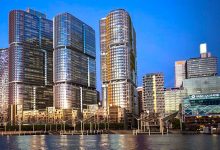Australian construction company Lendlease has announced that it has achieved carbon neutrality across all of its Australian construction sites, and will continue to seek ways to reduce embodied carbon emissions in building materials like steel and concrete.
Lendlease says it achieved its carbon neutral status by adopting lower emissions construction practises across all its sites, and offsetting the remaining emissions through a partnership with the ‘Revive the Reef’ carbon offset program.
“Lendlease has a long-held the view that truly great places should deliver positive environmental and social outcomes, alongside financial value,” Lendlease building CEO Dale Connor said.
“In response to the pressure climate change has on our planet and people, our Australian Building business has very recently become one of Australia’s first carbon neutral constructors. This is something I’m incredibly proud of.”
The company said that it would be looking to offer the Scope 1 (direct) and Scope 2 (indirect) emissions that the company reports under the National Greenhouse and Energy Reporting scheme, which amounted to just over 282,000 tonnes in the latest report published for the 2017-18 period.
Such emissions would largely relate to the energy used by the company at construction sites, including from on-site generators, as well as the emissions associated with electricity consumed by the construction operations.
Lendlease also indicated its commitment to reducing the ’embodied’ emissions associated with emissions intensive building materials like steel and concrete.
The company estimates that around 10 per cent of the world’s greenhouse gas emissions are associated with the production of building materials, and seeking lower emissions alternatives will be a crucial part of tackling climate change.
The company acknowledged that purchasing carbon offsets may be seen as an easy alternative to directly reducing emissions from the company’s activities, but recognised that they could provide an “immediate” way for the company to reduce its emissions, while the company continued to search for ways to reduce its carbon footprint.
“There is sometimes concern that offsetting is the ‘easy way out’ and that effort should be spent trying to eliminate emissions rather than offset them. However, it’s important to acknowledge third party certified offsets are an important interim step in addressing climate change,” Lendlease head of building sustainability Ann Austin said.
“Offsets provide a way to take immediate action to slow climate change, while solutions to completely remove emissions directly from our construction activities are progressed. Well selected offsets make a real and measured impact on reducing climate change that would otherwise not occur.”
Lendlease had partnered with the ‘Revive the Reef’ initiative to purchase emissions offsets, through the Colodan Native Forest Project offsets project seeks to achieve emissions reductions by avoiding land clearing in the region between Gladstone and Bundaberg in Queensland.
The project will regenerate around 3,000 hectares of native woodlands, and will prevent around 500 hectares of native forest from land clearing.
The project seeks to generate additional co-benefits for the Great Barrier Reef by maintaining water quality and helping to minimise agricultural run-off into the reef’s waters.
Queensland has attracted strong criticism for the level of land clearing that has occurred in the state in recent years, which at one point was keeping pace with the level of destructive land clearing that was occurring in Brazil.
Lendlease has previously committed to achieving zero net emissions across its established property portfolio by 2025, with the support of the Clean Energy Finance Corporation. The government-owned green bank announced last year that it would make an investment in Lendlease’s property portfolio to support the company decarbonise its property holdings.










